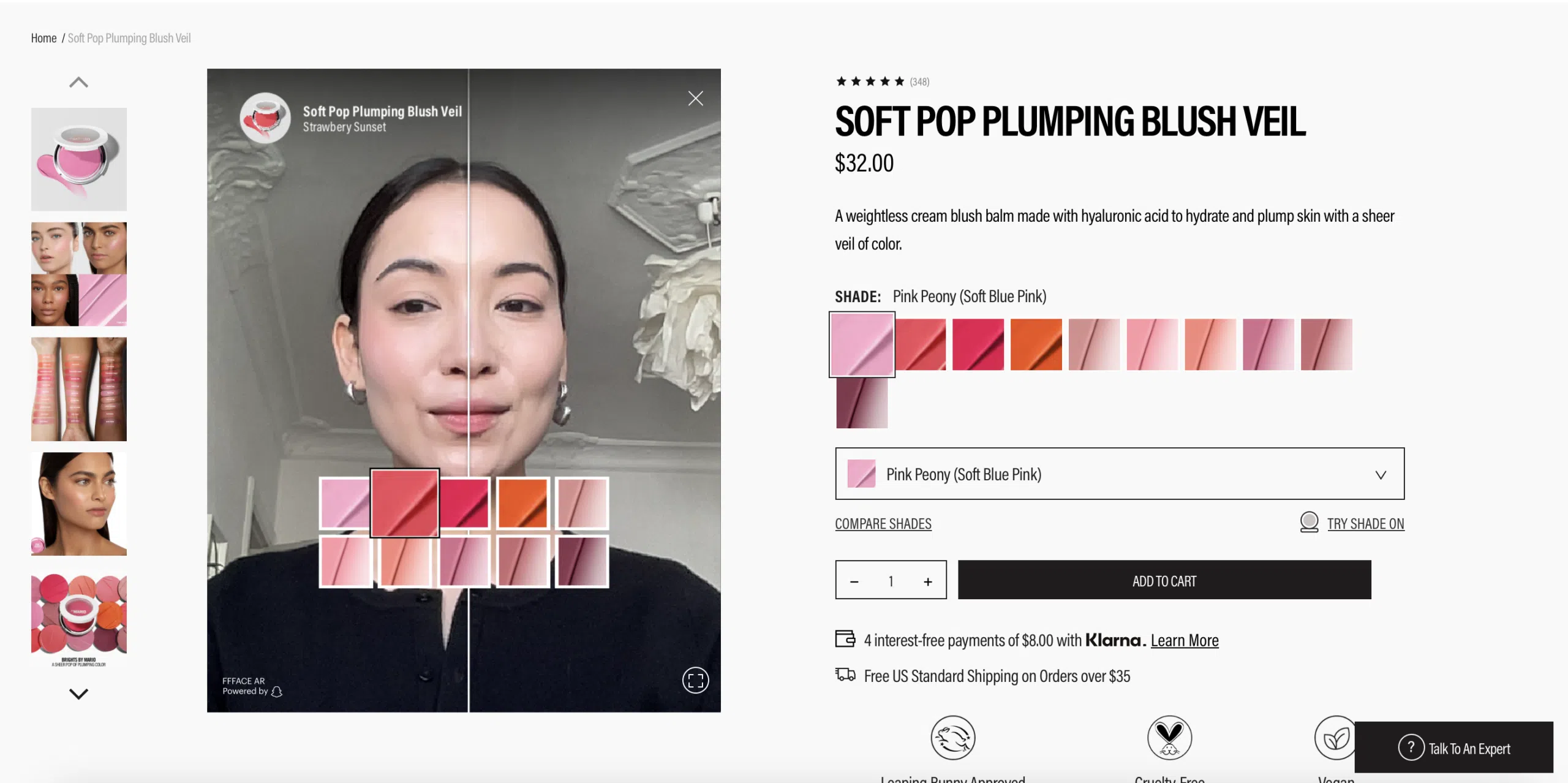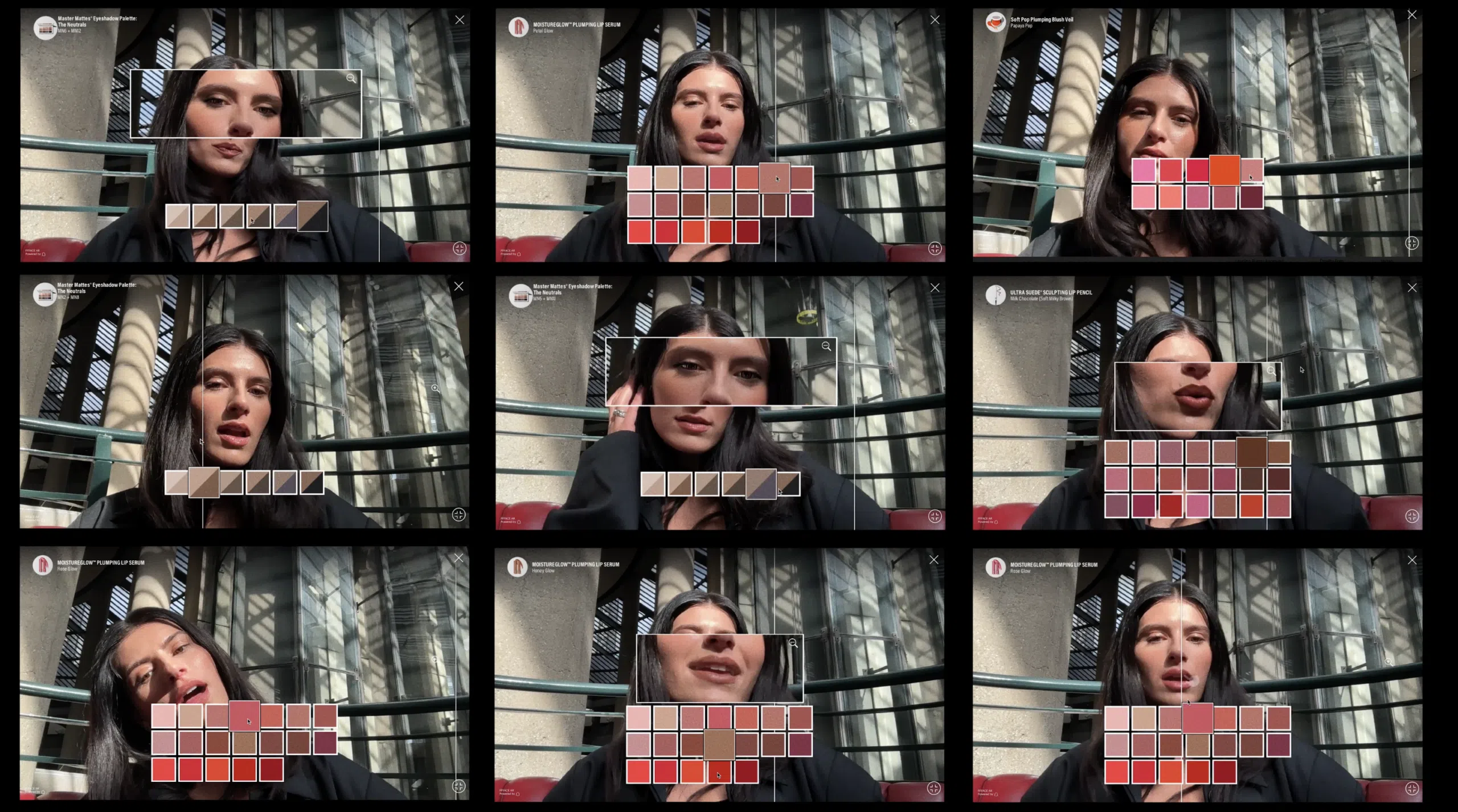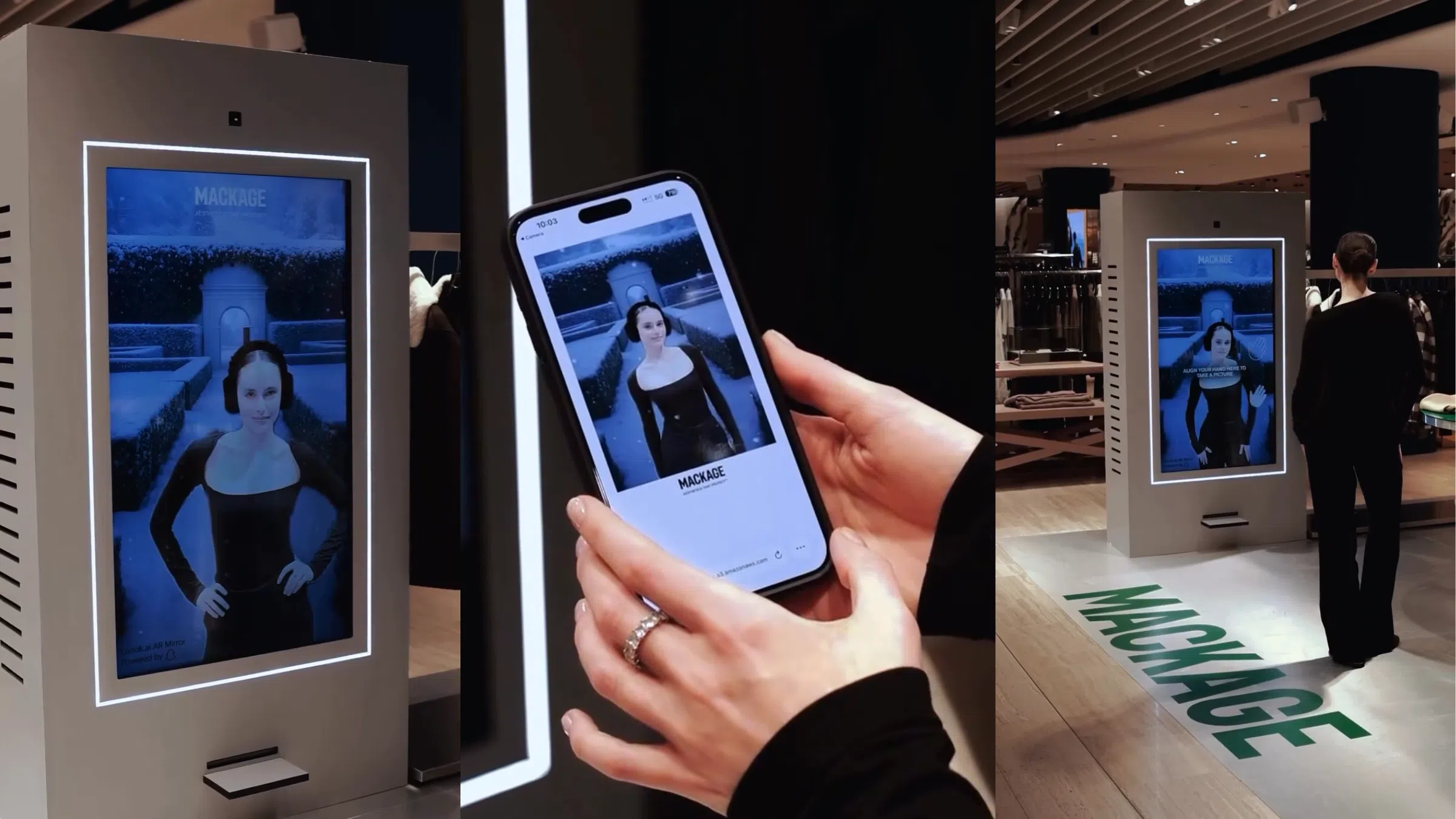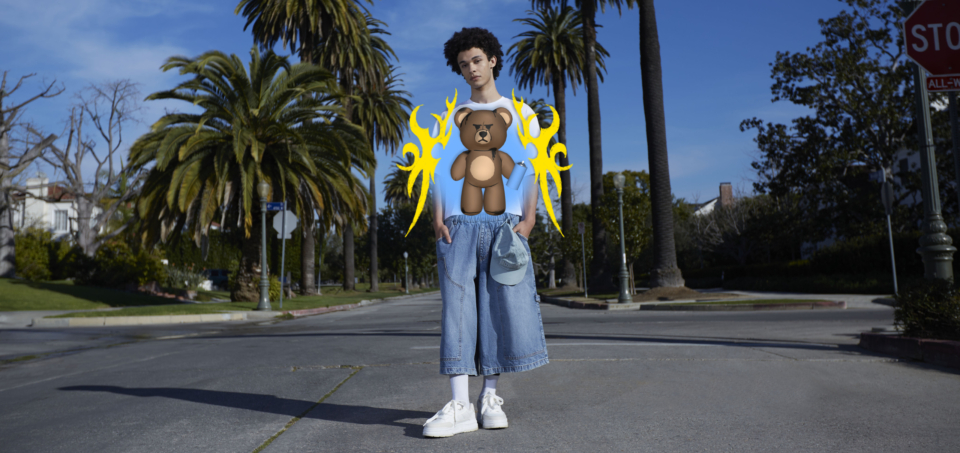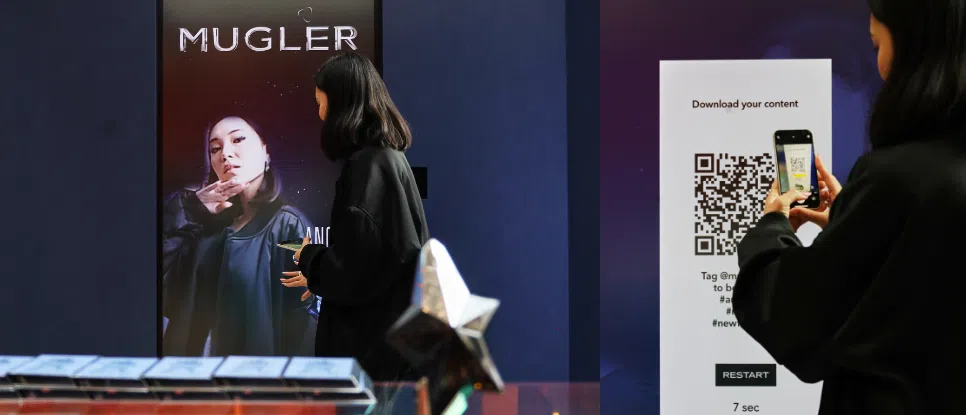Augmented Reality in E-commerce: Benefits, Examples, and How to Get Started

TL;DR — AR in E-commerce
Augmented Reality in e-commerce lets shoppers interact with digital products through their phone camera, using WebAR, app-based AR, or social AR filters. Customers can virtually try on items like makeup and glasses or place 3D furniture and décor in their real space.
AR reduces uncertainty, increases conversion rates, lowers return rates, and boosts engagement, making it a strategic advantage for brands. Key use cases include virtual try-ons, product visualization at home, virtual showrooms, and social-media AR effects.
To get started, brands can add a simple WebAR or try-on feature, create accurate 3D product models, and embed AR on their website, app, or social channels. Tracking performance over time helps scale AR across more products.
Overall, AR is becoming an effective tool for improving online shopping confidence, sales, and customer experience.
What is Augmented Reality in E-commerce?
Augmented Reality (AR) is no longer just a buzzword—it’s the game-changer quietly (and sometimes not so quietly) reshaping the world of online shopping. By layering digital elements over the physical world, AR gives customers the ability to try before they buy, from the comfort of their couch. Whether it’s testing out a lipstick shade, placing a virtual couch in your living room, or trying on glasses through your phone camera, AR is turning imagination into interaction.
And the numbers don’t lie: 76% of consumers want to use AR as a practical tool in their everyday lives, and brands that integrate AR into their ecommerce experiences are seeing conversion rates soar—some up to 94%. With nearly all smartphone users expected to be AR users by 2025, this technology is rapidly becoming an essential part of the digital shopping toolkit.
In short: AR isn’t some sci-fi fantasy. It’s here, it’s powerful, and it’s already transforming how we shop online.
At its core, Augmented Reality (AR) enhances the real world by adding digital visuals and interactions—think of it as a digital layer that lives on top of what your phone camera sees. This is different from Virtual Reality (VR), which immerses users in a completely virtual world that replaces their surroundings.
In e-commerce, AR allows customers to interact with 3D products in real time. They can rotate, scale, and place items in their actual environment to see how something looks and fits—before clicking “Add to Cart.” It’s not just cool; it’s confidence-boosting.
There are a few main types of AR delivery in online retail:
- Web-based AR: Accessible through a browser with no app download required—great for frictionless experiences.
- App-based AR: Usually more powerful and interactive, but requires users to install an app.
- Social media AR filters: Found on platforms like Instagram and Snapchat, these branded experiences are fun, shareable, and incredibly effective at driving engagement.
With the right strategy, AR can turn casual browsers into loyal buyers—and make online shopping feel just as tangible as walking into a store.



Why AR Matters for E-commerce
Modern shoppers seek interactive experiences that let them try products virtually before buying. AR transforms online browsing into an engaging experience where customers can preview and test items confidently. Acting as a bridge between physical and digital shopping, AR lets customers visualize products in their space – from trying on shoes to placing furniture – making online purchases more tangible and personal.
And the numbers speak for themselves:
- AR experiences can lead to a 40% increase in customer engagement.
- 61% of shoppers say they prefer retailers that offer AR, and 71% say they would shop more often if AR were available.
- According to Shopify, products with AR content saw a 94% higher conversion rate than products without it.
- 70% of consumers said they are more loyal to brands that incorporate AR into their shopping experience.
- Global spending on AR in retail is projected to hit $8 billion by 2026.
With more than 1.7 billion mobile AR users worldwide in 2024—and that number expected to grow rapidly—e-commerce brands that embrace AR aren’t just innovating, they’re future-proofing.
Bring Your Products to LifeTop E-commerce AR Use Cases (with Real-World Examples)
AR technology is incredibly versatile, and e-commerce brands are using it in creative ways to elevate the online shopping experience. Here are the most powerful and proven use cases that are reshaping how customers interact with products and brands:
Web AR for Virtual Try-Ons (Beauty, fashion, eyewear)
This is one of the most popular applications of AR in retail. Shoppers can try on makeup, clothing, shoes, or glasses directly from their smartphones or desktop cameras—no fitting room required. From testing foundation shades to seeing how a pair of sunglasses fits their face, virtual try-ons reduce uncertainty and boost buyer confidence. Brands like Maybelline, Prada, and Makeup by Mario are already using this tech to great effect.
Makeup by Mario Website Try-on Example
Makeup by Mario, the beauty brand founded by celebrity makeup artist Mario Dedivanovic, has integrated augmented reality (AR) virtual try-on features directly into its website to enhance the online shopping experience. Shoppers can try on products like the SurrealSkin™ Foundation and SoftSculpt® Shaping Stick in real time using their device’s camera, allowing them to visualize shades and finishes on their own face before making a purchase. Powered by Snapchat’s free web SDK and developed in collaboration with AR tech studio FFFACE.ME, the experience is seamless, personalized, and accessible without requiring an app.
Preview Placement (Furniture, home decor)
Ever ordered a piece of furniture only to find out it doesn’t fit or match? AR fixes that. Preview placement tools let shoppers drop true-to-scale 3D models of products right into their own space using their phone’s camera. Whether it’s a couch, lamp, or wall art, customers can see how it fits, looks, and feels in context before purchasing. IKEA Place and Burrow’s AR tools are perfect examples of this in action.
Neutrum Furniture AR Placement
FFFACE.ME partnered with Neutrum to let customers visualize minimalist furniture in their homes using AR. The technology enables users to see how pieces fit and look in their space before buying, creating a seamless bridge between online shopping and real-world placement.
AR Filters for Social Media Marketing
AR isn’t just for shopping—it’s also a content marketing superpower. Brands can launch interactive AR filters on Instagram, TikTok, or Snapchat to promote new collections, limited drops, or campaigns. These filters are fun, highly shareable, and can go viral fast—turning customers into content creators and giving your brand massive organic reach.
AR TikTok Game for Maybelline
To launch Superstay Teddy Tint, Maybelline Germany teamed up with FFFACE.ME to create an interactive TikTok AR filter game. Users tap to catch Teddy Tints, see each shade applied in real time, and explore the full color palette—all within the game.
The filter boosts engagement by combining virtual try-on, gamification, and a giveaway (win the full display by entering before March 31st). It’s a fun, social-driven way to let users test products, share with friends, and connect with the brand on TikTok.
Virtual Showrooms & Pop-Up Experiences
AR makes it possible to create full-blown virtual environments that replicate the feel of physical retail spaces—without the overhead. Virtual showrooms allow customers to browse and interact with collections as if they were walking through a boutique. Pop-up AR experiences can be geo-targeted or event-based, making them perfect for product launches or limited-time campaigns. They’re immersive, memorable, and built for modern consumers.
Fendi AR Mirror Experience at Istanbul Airport
Fendi partnered with FFFACE.ME to create hands-free AR Mirrors at Istanbul Airport. Travelers could virtually try on Fendi accessories using gestures and print photos of their looks. This contactless experience elevated Fendi’s presence in travel retail, demonstrating how AR technology can enhance luxury shopping for on-the-go customers.
AR Product Packaging: Turning Boxes into Interactive Brand Experiences
The core purpose of AR product packaging is to transform static packaging into a dynamic customer engagement tool. By scanning a label or box with a smartphone, consumers can instantly access interactive content — from 3D product visualizations and how-to videos to mini-games, virtual try-ons, or behind-the-scenes brand stories. This not only enhances the unboxing experience but also extends the product’s value long after purchase. AR packaging strengthens brand connection, educates users, and creates a direct digital bridge to loyalty programs, e-commerce, or social channels — all while making the product itself part of the storytelling.
AR Packaging for a Flower Brand
FFFACE.ME created an AR packaging experience for a flower brand that transformed each bouquet into a digital moment. By scanning the wrapping, customers unlocked personalized 3D animations and greetings — turning a simple gift into an interactive, emotional experience. This solution deepened brand connection and encouraged social sharing, making flowers not just beautiful, but memorable.
These use cases prove that AR isn’t just a gimmick—it’s a flexible tool that solves real customer problems while unlocking new creative possibilities for brands.
Benefits of AR for E-commerce
AR in e-commerce delivers clear value: it boosts conversions, cuts costs, and transforms how customers shop. Here’s a look at the key benefits:
- Enhanced Product Visualization: AR helps shoppers visualize products before buying. From trying on makeup and shoes to placing furniture in their space, AR delivers realistic 3D previews in real environments. This eliminates uncertainty and makes online shopping more intuitive.
- Reduced Return Rates: Returns cost brands millions and frustrate customers. AR helps by letting shoppers accurately preview items before buying. Virtual try-ons for size, style, and color lead to confident purchases and up to a 25% drop in returns.
- Increased Customer Engagement: AR grabs attention where static images don’t. With interactive try-ons, 360° views, and engaging filters, shoppers spend 40% more time exploring products compared to standard pages.
- Personalized Shopping: AR personalizes content based on user data, offering custom product suggestions, size recommendations, and style matches that adapt to each shopper’s preferences in real time.
- Boosted Brand Awareness: AR features spread quickly on social media like Instagram, TikTok, and Snapchat. Try-on filters and virtual stores can go viral fast, creating organic marketing and user-generated content.
- Cost Savings for Brands: AR reduces returns and customer support needs while eliminating the need for physical samples and large inventories. This translates to improved profit margins for retailers.
- Improved Accessibility: AR makes online shopping more accessible. Voice-guided AR tools and audio descriptions help visually impaired users, while customizable overlays support those with sensory needs. This creates a more inclusive retail experience.
In short: AR doesn’t just enhance the shopping experience—it improves it across the board. For customers, it’s more immersive, accurate, and fun. For brands, it’s a powerful tool to drive sales, loyalty, and operational efficiency.
Boost Sales with AR Try-OnHow to Implement AR in Your Online Store
Ready to bring your store into the AR age? Great news—adding AR to your e-commerce experience is more achievable than ever. But like any powerful tool, it works best when it’s done with purpose and strategy. Here’s a step-by-step guide to implementing AR that actually delivers results:
| Step | Action | Key Points |
|---|---|---|
| 1. Define Goals | Set clear objectives | Reduce returns, Increase engagement, Drive sales, Build innovation |
| 2. Research Customers | Analyze user preferences | Mobile vs desktop, AR feature interest, Social media usage, Personalization needs |
| 3. Choose Technology | Select AR platform | Web-based AR, App-based AR, Social AR, Turnkey solutions |
| 4. Create Assets | Develop 3D content | 3D product models, Proper scaling, Textures & lighting, Device testing |
| 5. Integration | Implement AR features | Platform compatibility, Loading optimization, UX testing, Mobile responsiveness |
| 6. Monitor | Track performance | Engagement metrics, Conversion rates, Bounce rates, Return rates |
AR E-commerce Challenges and Considerations
As exciting as AR is, implementing it in e-commerce comes with a few hurdles to be aware of. Addressing these early will help you create smoother, more successful AR experiences:
- Cost of 3D Content Creation: High-quality 3D models don’t come cheap. Creating true-to-scale, photorealistic assets requires skilled designers and advanced tools. Start with a few key products to test impact before scaling.
- Device Compatibility: Not all shoppers have the latest iPhone or AR-ready Android. Make sure your AR experiences degrade gracefully for older devices or offer alternative ways to interact.
- Data Privacy and Personalization Balance: AR often uses camera input and behavioral data to personalize experiences. Be transparent about data use, and ensure your app complies with privacy regulations like GDPR and CCPA.
- UX Design and User Onboarding: AR should feel intuitive—not confusing. Clear instructions, smooth loading, and minimal clicks are essential. If users don’t know how to engage with it, they’ll skip it. A quick tutorial or “try it here” button goes a long way.



The Future of AR in E-commerce
The AR experiences we know today are just the beginning. As technology advances, we’ll see AI-powered personalization transform the shopping experience. Smart algorithms will analyze user preferences to provide tailored product suggestions, automatic size adjustments, and even recommendations based on your mood – all seamlessly integrated into AR interfaces.
The way we interact with AR will also evolve beyond our smartphones. Wearable devices like AR glasses and smart mirrors are already appearing in retail stores, enabling hands-free shopping experiences with full-body virtual try-ons. Voice commands will make these interactions even more natural, allowing shoppers to easily adjust colors, sizes, and styles with simple verbal requests.
Perhaps most exciting is the emergence of virtual shopping environments. Digital malls and showrooms will become part of the metaverse, creating immersive spaces where people can browse collections, participate in product launches, and shop alongside friends in real-time. These virtual spaces will blend the convenience of online shopping with the social aspects of traditional retail, all enhanced by advanced AR technology.
Bring Your Online Store to Life with AR – Powered by FFFACE.ME
Ready to bring your online store to life? Whether you’re in beauty, fashion, furniture, or lifestyle—AR is the upgrade your e-commerce experience needs. From virtual try-ons to 3D product previews, augmented reality turns browsing into buying. If you’re looking for a partner to make it happen, FFFACE.ME is one of the leading creative tech agencies specializing in AR solutions for forward-thinking brands. Want to boost engagement, cut returns, and wow your customers? Now’s the time to explore AR for your business—and FFFACE.ME can help you do it beautifully.
Explore AR Solutions with FFFACE.MEConclusion
Augmented Reality is no longer optional for e-commerce—it’s a competitive edge. The brands embracing it today are already seeing higher engagement, lower returns, and stronger customer loyalty. As the tech becomes more accessible and expected, shoppers will gravitate toward brands that offer these immersive experiences.
The good news? You don’t have to do it all at once. Start small, stay strategic, and evolve as you go. But whatever you do—don’t wait. The future of online shopping is interactive, immersive, and powered by AR. Now is the perfect time to plan your move.




